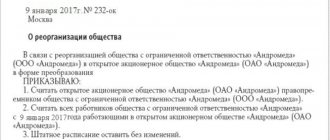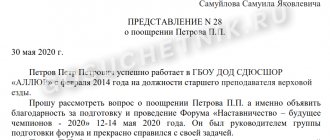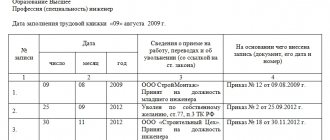Common mistakes
Typically, erroneous information appears for objective reasons (change of surname due to marriage, reinstatement of an employee by court decision) or due to the inattention of the specialist who fills out the document. Most often you can notice:
- incorrect indication of the worker’s first, patronymic and last name on the title page;
- incorrect dates of hiring, transfer to a new position, dismissal;
- inaccurate job title;
- missing letters, grammatical errors.
Since even one wrong character can cause a dispute when an employee goes to apply for a pension, personnel officers must be extremely careful. You should always check with the employee’s other documents - passport, birth certificate, marriage certificate, education diploma. And if an inaccuracy does creep in, it must be corrected correctly.
Who will correct the mistake
In conclusion, we note that an employee can, but is not obligated to, go to the company where he previously worked to correct entries in the work book. And sometimes this is simply impossible - the company no longer exists. At the request of the employee, changes are made by the responsible person of the organization where he currently works.
The company can send a request to the previous employer and, based on his official response, make corrections to the work book. This can be done on the basis of copies of orders on hiring, transfer and dismissal, on the cancellation of these orders, as well as certificates and extracts from documents in which these orders are mentioned (personal card, personal account, order registration book, etc.) (Clause 27 of Resolution No. 225).
If the organization has been liquidated, supporting documents should be requested from the archives.
Changes and corrections in labor: how to do it correctly
In accordance with Section III of Government Decree No. 225, the employer may correct:
- surname, first name, patronymic;
- date of birth;
- information about education;
- name of the employee’s profession or specialty;
- information about awards.
The main rule of the personnel officer when correcting erroneously entered information is no crossing out. This is only permissible when correcting incorrect information on the title page. In other cases, changes are made by recognizing certain entries as inaccurate and making correct ones. In this case, the new data must be certified by the signature of the responsible person and, if available, the seal of the organization or personnel service.
Clause 1.2 of Resolution of the Ministry of Labor of Russia No. 69 specifies exactly how amendments should be made. Here is an example algorithm:
- Indicate the serial number.
- Enter the current date (day, month, year).
- In the next column, write down exactly what information is not true and what it should be replaced with.
- In the last column, indicate the details of the order or document on the basis of which the correction is made.
Please note: this algorithm is relevant for correcting information not only about labor documents, but also about inserts for them.
Sample correction in the work book 2020
Who is entrusted with the right to make adjustments in labor registers
Only responsible employees separately assigned to the position of managing personnel records and labor issues (according to a specially issued local act) can correct entries in the personal labor register. This may include:
- The director of an organization or an individual entrepreneur who takes over personnel records management (with certain wording in the order).
- Accounting employee - as a rule, this function is assigned to the accounting department when micro and small enterprises do not have a personnel service on staff.
- HR officers usually conduct labor records at medium and large enterprises.
- Company lawyer in charge of personnel matters.
The key requirement here is that the basic rule of personnel document flow must be observed: correction of a record is allowed only after reviewing the documentation confirming the incorrectness of the record and the presence of an error.
Both the employee who made the mistake and the official from the new place of work of the work record holder have the right to make a note about the invalidity of the entry, even if the employee has already changed several places of employment by that time. Here it is important to be guided by the requirements of the law, which provide for documentary evidence of the fact, therefore, when correcting the mistakes of another employer, you need to obtain an official document from him.
The main documents to rely on when making corrections:
- Decree of the Government of the Russian Federation “On work books” No. 225, issued on April 16, 2003.
- Resolution of the Ministry of Labor and Social Development of the Russian Federation No. 69 of October 10, 2003.
Making corrections to entries previously made by another company
Option 1. Correct for another organization
Based on the relevant documents, the employer who discovered or made an inaccuracy himself can correct any section in the work book. An employee is not required to go to the company where he previously worked to correct incorrect data. Moreover, sometimes this is simply impossible. At the request of the worker, changes are made by the responsible person of the organization where he is currently employed.
What documents can confirm the correction of erroneous information? It all depends on the situation. This could be a certificate from the archive, a court decision, or a copy of the document confirming the basis for correcting the data, confirmed by the previous employer. Witness testimony in this case has no legal force.
Option 2. The employee turns to the previous employer for correction.
If a person finds incorrect information in the Labor Code, he can contact his previous employer with a request to correct it. If he is already employed, then he writes an application with a request to give him a work book in order to make corrections to it. Then he brings the document to the human resources department of his previous employer, where he must correct the inaccuracies.
If a person does not have a new job, after the lines with information about dismissal, the former employer writes which entry is considered invalid.
If the ex-employee has already found a job, and new entries have appeared in his employment record, the former employer follows the following algorithm:
- Writes the name of the company.
- Indicates the next entry sequence number and date.
- In column 3, he clarifies which information is incorrect and enters the correct information.
- In the last column enters the details of the base document.
How to correct an incorrect entry after dismissal
If an incorrect entry is discovered by a person who has already resigned from the place of work where the error was made, he should contact this particular company. This is the easiest way to record a discrepancy and correct the error. If the former employer does not make contact, you can resolve the issue in court. But this is a rather lengthy process that will require a lot of time and effort (at least to collect evidence). On the other hand, such a claim can result in appropriate compensation and even (if desired) reinstatement at work.
But when an erroneous entry appears after a fairly long period, and even more difficult - when the enterprise no longer exists and there is virtually no one to ask, there is another way. The first step is to secure the support of your current employer. If a person is employed, the employer is simply obliged to try to correct the mistake or recognize the document as invalid and prepare a duplicate work record book for the person.
But when restoring a document from the last place of work, a person may have certain difficulties confirming work experience in previous places. After all, the employer has the right to enter into the employment document only data that is 100% confirmed by documents. And this can only be done after receiving official answers from former employers or data from the archive (if the company has been liquidated). And this is a rather complex and lengthy process. But we note that the legislation regulates this issue and agrees that labor gaps in a duplicate work book are acceptable. This conclusion can be made on the basis of paragraph No. 32 of the Rules, ratified by normative act No. 225, as well as by Decree of the Government of the Russian Federation No. 69 (see paragraph 7.2). Thus, these acts regulate that, together with a duplicate, a person’s work experience can be confirmed by one of the following documents:
- original employment contract;
- financial certificates and statements recording the fact that the employee received payment for work at a specific enterprise (for example, certificate 2-NDFL, other payment forms that are issued upon dismissal);
- orders on employment and dismissal;
- monthly payslips in which the salary amount is recorded.
This register of documentation accompanying and confirming work experience is also indicated in the latest Decree of the Government of the Russian Federation on this topic - No. 1015 (clause 11).
As a last resort (if the company is liquidated), there is archival data where you can get a certificate and an extract from the labor record book, which can prove that a labor register with certain details was issued.
A small nuance: if, when hiring, it was discovered that there is no organization stamp in the labor register of the hired employee, when restoring this gap, you need to carefully consider the seal imprint. If suddenly the name or legal status of the company has changed over the past period, it is prohibited to put an updated seal. Inconsistencies between the name of the company indicated in the register and the seal will automatically invalidate the document. The solution here should be the following - to justify that at the time of receiving the work book the person was working here. This means that you need to have a document on hand indicating this, for example, a certificate-extract from the journal of the movement of work books or a 2-NDFL certificate for that year or other documents confirming the fact of employment.
Corrections on the title page
All incorrect information on the title page is simply crossed out. The exact version, certified by signature and seal, is indicated next to it. This applies to cases where an employee has changed personal data, as well as situations where an error was made due to the inattention of the person who filled out the document.
It is recommended that the correction of the full name. employee on the title page was made by the employer who created the work book. Because only he can know exactly in whose name he issued this document. To avoid problems with assigning someone else’s labor code, the employee should be sent to the very first employer. If the company is liquidated or refuses to correct inaccuracies, the employee can go to court and demand that this work book belong to him.
If you need to indicate a new specialty or additional education on the title page, you do not need to cross out anything. In this case, put a comma in the required line and write new data.
If there is an error in the data of the owner of the book
The situation is more complicated with the correction of errors made in writing personal information about the employee. Double spelling of some names or incorrect reproduction of the patronymic are quite common mistakes when filling out the title section of the work book.
The regulatory documents do not contain any recommendations regarding the correction of errors in the surnames or names of the owners of work records.
The practice of personnel records management offers the following algorithm of actions:
- If the error was discovered by the employer who created the work book and entered the initial data, then it is recommended to issue the employee a new document form, where to write down the information in strict accordance with the passport data. In this case, the old work book is written off like a spoiled form, with the corresponding act being drawn up.
- If incorrect writing of personal information about an employee is detected by the second and subsequent employers, it is allowed to issue a duplicate of the work book. Information about previous work experience is entered in duplicate on the basis of official certificates issued at previous places of work.
Important! A duplicate work book is not a copy of the one in which inaccuracies were found in the spelling of the employee’s last name/name. Information about length of service should be entered not according to the “old” work book, but according to correctly executed documents from previous places of work.
In the practical work of personnel services, we encounter the same approach that is provided for changing information about an employee according to official documents - crossing out an incorrect entry and entering the correct data.
Such actions are illegal and may subsequently cause problems for the employee with the Pension Fund.
Errors in award information
For most employees, this section is empty, since this place contains information about awarded diplomas, certificates, titles, and other awards. Therefore, awards pages often end up with unnecessary information. In this case, the responsible person recognizes the entries as invalid, signs, puts a seal (if any) - in general, acts according to the general rules.
You must act in the same way if there is an inaccuracy in the dates, details of the foundation document, company name, or other data.
Features of making changes to the title page
Typically, changes are made to the title pages (according to clause 2.3 of the Instructions), not corrections. What to do if there is an incorrect entry on the title page in the work book? When preparing the title page for the first time, inaccuracies and corrections are unacceptable. If an error or inaccuracy was entered, then such a form must be destroyed, creating a special act, and a new form must be used. You can attach to the act of liquidation of incorrect forms the original number, which is first cut out from the form being eliminated before it is eliminated. This serves as official proof of the existence of the form with the required number. Employees will not be charged any money for damaged forms.
When making any adjustments, it is important to remember that old data should be crossed out with one line, and new data should be entered above the old ones. Old data must remain legible. On the inside of the labor document, it is necessary to leave a link to the document regulating the introduction of certain changes, as well as the signature and seal of the responsible organization or employee of the personnel department.
It is prohibited to make any adjustments to the book based on the words of its owner. Only various personal documents can serve as grounds:
- passport}
- certificate of divorce}
- Marriage certificate}
- identification code and other documents.
The information in the employee book about their profession and education is unchanged; it can only be supplemented. If such information is not available in the labor document, you simply need to fill in the required lines.
Inaccuracy in maintaining a work book is also possible when making adjustments to the title page. Then changes are made as usual, because the recorded information does not supplement information about work, dismissal or reward. Errors in making adjustments to the title page are corrected by the current employer on the basis of the document regulating the introduction of such amendments (clause 27 of the Rules). An incorrect entry must be crossed out with one neat line and the correct information must be entered. On the cover, on the inside, it is necessary to make an appropriate entry with a detailed note of the correction. This entry must be certified with the signature and stamp of the organization.
Clause 30 of the Rules prohibits blurring, crossing out, falsifying erroneous or incorrect entries in any sections of the work book that contain information about positions or awards. An erroneous or inaccurate entry is simply invalidated and the correct information is entered. To do this, the corresponding columns must contain the following:
- column 1 – sequential number following the last entry}
- column 2 – date of entry}
- column 3 – indication of the invalidity of the entry with the number and the correct entry}
- Column 4 – number of the order on the basis of which the erroneous entry was made. If an order was issued with an error and then canceled, then the number and date of the order canceling it is entered.
The same procedure for making adjustments must be followed when correcting all erroneous and incorrect entries - about hiring, rewarding, dismissal. This also includes information about dismissals declared invalid by the Rostrudinspectorate, the court or directly by the employer. There must be an appropriate reference to the order or other order of the employer to change the wording of the reasons for dismissal or reinstatement.
In the case where it is necessary to restore, following the established procedure and norms, continuous work experience in the last position, a special entry is required in the third column with information about the work. At the same time, in the fourth column it is necessary to indicate a link to the name of the document on the basis of which the information was entered, as well as its number and date. This requirement is regulated by clause 3.4 of the Instructions and clause 23 of the Rules.
The employee, in accordance with clause 33 of the current Rules, applies to receive a duplicate of his work report, where the required information will be entered correctly.
Do spelling errors need to be corrected?
Spelling errors are usually caused by inattention. If a letter is missing or mixed up in the termination information, no one will probably notice. But when a spelling error occurs in a specialty, a company name, or an appointment record, it can be costly for the employee. If, when assigning a pension, Pension Fund employees find fault with a “typo,” the employee will have to prove the right to state pension provision and length of service in court.
What errors are most often corrected in work books?
Corrections in the book are required due to an oversight by the specialist who filled out the document, due to changes in personal data (employee's first and last name), changes in the situation - for example, when an employee was reinstated at work by a court decision.
The most common errors are:
- incorrect spelling of the employee’s first, last or patronymic name;
- incorrect dates of personnel events: hiring, transfer to another position or division, dismissal;
- incorrect job title;
- typos, grammatical errors.
A correctly executed work record book will help the employee, when applying for a pension, to avoid disputes with the Pension Fund. Otherwise, long-standing inaccuracies in the document will have to be corrected. Therefore, when filling out the book, you need to be very careful: check the employee’s documents, and if you find any inaccuracies, correct them correctly.
The legislative framework
Filling out work books is subject to several regulatory documents, including:
- Labor Code of the Russian Federation;
- Instructions approved by Resolution of the Ministry of Labor dated October 10, 2003 No. 69, containing the rules for filling out work books;
- Rules for maintaining and storing books, approved by Government Decree No. 225 of April 16, 2003.
The Labor Code in Article 66 defines the work book as the main document that stores information about the working life of a citizen. Therefore, when hiring a new employee, employers are obliged to issue an appropriate order and, on its basis, make an entry in his work book. The only exception is part-time work.
Since this document is maintained throughout the citizen’s entire working life, all entries made in the document should not cause criticism from the authorities carrying out the inspection. Therefore, errors made must be corrected on time and in accordance with the Instructions for filling out.
Not all personnel officers are attentive to making entries in the work book; they do not attach importance to numbering or the accuracy of information related to admission, transfers and dismissal. But ultimately, all these errors may result in a refusal to consider such records when assigning a pension.
This is especially important when the citizen actually worked in harmful and dangerous work, and the record turned out to be incorrect. In accordance with current legislation, such a record will have to be clarified, or pension fund specialists will be forced to deny the citizen early retirement.
Features of changing information in the insert
The insert in the labor document is opened in cases where the resource for new information has been exhausted. The issue of the insert is recorded on the inside of the title page of the work report: the series and number of the new insert are entered.
If an error is made and detected at the beginning of the preparation of the insert, then it is eliminated with the drawing up of an act. After this, a new insert is issued, the number of which is also recorded on the title page of the TC.
The procedure for correcting incorrect information in the insert is similar to that established for the TC. The correction is confirmed by the seal of the organization and the signature of the official who made the correction.
In some cases, the numbering of entries in the insert may be incorrect. As a result, two records appear under the same number.
Such errors cannot be corrected by simply crossing them out. To correct errors of this kind, an entry is made under the correct number, in which the incorrectness of the entry under such and such a number is clarified and the text of the entry is duplicated.
Invalidation of an entry
The main and most common way to correct inaccuracies in work book entries is to invalidate the erroneous data. Let's look at the procedure for such correction using an example.
In the section of the work book under serial number 14 there is a record of the dismissal of employee Stepanenko O.O. from 10/21/2015, made on the basis of order No. 121-k and a statement of resignation at his own request.
On the morning of October 21, 2015, the manager filled out the work book and prepared all the documents necessary for dismissal, but Stepanenko O.O. withdrew her application and decided to continue working in the organization. To cancel a dismissal record, the manager must take the following actions:
- Issue a new order that cancels the dismissal order (for example, No. 122-k).
- Make a new entry dated 10/21/2015 in the work book under serial number 15 of the following type: “Entry number 14 is invalid.”
- After the entry, indicate the date and number of the new order, on the basis of which the previous entry is invalidated (in this case, this is order No. 122-k dated October 21, 2015).
If the correction of the entry concerns another issue (for example, the employee’s position is incorrectly indicated), then in the second paragraph, after indicating the number of the invalid entry, you must also enter the correct data.
Sample of cancellation of an entry in an employee’s work book
Procedure and adjustment rules
Before taking any action when suspicious marks are detected in the TC, it is necessary to clearly understand the terminology used when working with the TC. This applies to the terms “correction”, “change”, “addition”.
The term “correction” is used in cases involving the replacement of an incorrect mark in the document in question. The terms “change” and “addition” imply a change or addition of information, respectively.
Example change
If an employee has made an incorrect mark in the Labor Code, he is recommended to contact the HR department, since issues of correct execution of the Labor Code fall within the competence of the employees of this department. However, not every enterprise contains such a department in its structure.
In this situation, the legislation of the Russian Federation allows the execution of a Labor Code personally by the employer, or by another specialist of the organization appointed by order.
An individual who provides a citizen with a job is prohibited by law from making adjustments to the Labor Code.
If incorrect information is identified in the document in question, the employee should:
- notify the employer about the identified incorrect data in the Labor Code and the need to correct them;
- provide the authorized person with documents on the legality of the information; to be entered to replace erroneous ones.
The following general rules are acceptable for correcting information:
Rules for correcting errors in the work book
When the organization that made an error in the Labor Code is reorganized or ceases to exist at the time the incorrect entry is discovered, the correction is made by the legal successor of the enterprise or a higher competent authority. If the specified options are not available, this problem is resolved in the enterprise archive.
Adjustments are made with a ballpoint or fountain pen containing waterproof and light-fast paste in purple, dark blue or black. Abbreviations are not allowed.










